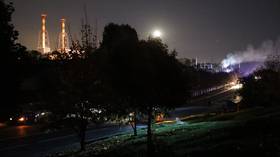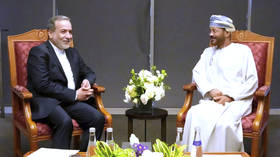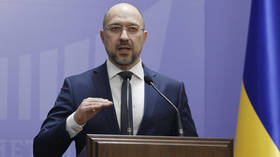Helping you to #QuestionMore: How RT brought stories on Gitmo MSM ignored
After years of bickering over torture and rights abuses, President Obama has rejected a plan to close Guantanamo Bay. Over its 10 years, RT has been among the few major news outlets working to put the facility under a magnifying glass. We recount the stories.
READ MORE: Helping you to #QuestionMore: How Assange became RT contributor & fugitive of the West
Established in 2002 as America went on the warpath dubbed ‘The War on Terror,’ the prison has been subject to years of human rights abuse allegations, including torture, the denial of attorney visitation or press access, and a series of very questionable and underreported practices going on inside the facility.
What is more, most of the inmates at the prison are being held without charge, just as one Mustafa al-Aziz al-Shamiri, 37, who – it was just found – was thrown into a cell because of a mistake with his name. The authorities were unable to do anything because of lack of evidence – a fact that kept al-Shamiri locked up for 13 long years.
Obama rejects plan to close Gitmo, build another on US soil – report https://t.co/Q9OjLRvzK8pic.twitter.com/BO4R7uttwD
— RT America (@RT_America) December 2, 2015It has now been seven years since US President Barack Obama promised to do away with Guantanamo for good as part of his election campaign. Now, in 2015, the president has reportedly rejected the idea, saying it would be too costly. The proposal was considered and thrown out in November.
RT went to Guantanamo in October 2013 to lift the veil of secrecy and get a first-hand account of the goings on inside the prison’s barbed exterior. Anastasia Churkina reported on how closely supervised her every move had been. “Even though transparency’s a word brought up by all the personnel we talked to on the ground, we, as journalists – access to detainees aside – are asked to be very careful about the shots we filmed, all the backdrops,” she wrote.
The prison was meant to house extraordinarily dangerous suspects. But the inmates, whether guilty or not, were all under such duress that their health had suffered either due to ill treatment or because they had resorted to tactics such as hunger strikes. The prison itself denied the existence of one such strike taking place in March 2013, even after it had been in progress for three weeks. The acts of defiance are thought largely to have started in response to abrupt confiscation of personal items by the wardens – including sheets, towels, family photos, books, and even religious CDs.
See RT’s continuous coverage of GITMO HUNGER STRIKE
“Arabic interpreters employed by the prison have been searching the men’s Qur’ans in ways that constitute desecration according to their religious beliefs, and that guards have been disrespectful during prayer times,” a statement by the Center for Constitutional Rights (CCR) said. This was on top of all the letters sent to the officials by the prisoners’ lawyers, appealing to them to attend to their clients’ rapidly deteriorating condition.
The next chapter of Guantanamo was marked by the practice of force-feeding – something that prompted many inmates to readily continue striking. Even as one official was telling RT that he had never heard of one inmate complain about the practice, a whole barrage of allegations from rights groups, lawyers, and advocates on the outside testified to the contrary.
“The force feeding that my clients have experienced at Guantanamo, they’ve certainly described it as torture. The restraint chair that they’re strapped to, they’ve actually called ‘a torture chair,’” Ramzi Kassem, a Gitmo detainee lawyer based in New York, told RT. One of our correspondents volunteered to undergo the procedure herself to ascertain the facts. “Request declined,” she reported.
Navy nurse faces expulsion after refusing to force feed Gitmo detainees http://t.co/XO9lylbnXz
— RT (@RT_com) September 16, 2014Years of demonstrations across the world have resulted in little action on the part of the United States, even as a multitude of campaigns aiming to depict the horrid nature of Guantanamo are ongoing.
‘12 years too many’: US activists to mark #Gitmo anniversary by rallying for closure http://t.co/fvhQCuchkV#Guantanamo@NastiaChurkina
— RT (@RT_com) January 11, 2014Obama was forced to start re-thinking the strategy for releasing and repatriating the inmates in great haste: held-up transfers were relaunched and cases were again opened up for consideration. However, this led to another problem: the US was now repatriating people to countries where they faced danger.
There have been further allegations that the CIA has tried to recruit some of the detainees in exchange for freedom, while others spoke of the danger of radicalization once certain disgruntled individuals found themselves free to inflict revenge on the US.
Briton released from Guantanamo & awarded £1mn believed to have joined ISIS http://t.co/MKretyJPHlpic.twitter.com/xMRQ1HS5aa
— RT (@RT_com) October 11, 2015RT interviewed Guantanamo spokesman Robert Durand, who denied any and all allegations that have been leveled at the prison authorities by the many lawyers and human rights advocates during 11 years operation. However, US Federal Public Defender Carlos Warner – who represents 11 detainees at the prison – reminded the network that the hunger strikes were a reaction to Obama not making good on his promises to close the facility.
“All of them are without charge. First of all, all of them are innocent. Certainly, there isn’t evidence that could put all of them on trial, but we know that 86 of 166 our government has admitted are innocent and should be immediately released and are not a danger and they have places to go. So it remains on the president’s shoulders to do what’s right here and release these men,” Warner said in 2013.
Exactly two years since the hunger strike began, the Pentagon refused to grant the United Nations special rapporteur on torture, Juan E. Mendez, access to inmates in order to gather testimony. Despite Obama’s talk of transparency, the prison has remained as secretive as ever. “The invitation is to get a briefing from the authorities and to visit some parts of the prison, but not all, and specifically I am not allowed to have unmonitored or even monitored conversations with any inmate in Guantanamo Bay,” he told RT in March.
This problem of gaining unfettered access to supposed terrorists has remained a sticking point for the inmates’ numerous legal representatives.
The White House has often argued that Guantanamo cannot be closed without moving some detainees to US soil. Regardless, the president faces stiff opposition from Congress, which passed a law in 2011 prohibiting the administration from spending money to accomplish this.
Pentagon blocks UN torture investigator from meeting Gitmo detainees - report http://t.co/O02jjjZBQ6pic.twitter.com/ITBAYIKede
— RT (@RT_com) March 17, 2015Still, the White House is expected to send a plan for closing the facility to lawmakers in coming months. If worse comes to worst, the Obama administration may try to circumvent Congress on the issue of relocating detainees, claiming that their ban violates his prerogatives as commander-in-chief.
The spat over funding the relocation comes after millions of dollars were approved in the newly-approved NDAA for Ukraine and lethal aid for ‘moderate’ Syrian rebels.













